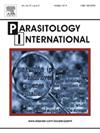Molecular and morphological characterization, phylogenetic affinities and new records of Trypanorhyncha (Cestoda) from the Mexican Atlantic
IF 1.5
4区 医学
Q3 PARASITOLOGY
引用次数: 0
Abstract
During a parasitological survey of elasmobranchs of the Atlantic Ocean on the Mexican coast, the digestive tract of some specimens of the southern stingray, Hypanus americanus (Hildebrand & Schroeder, 1928), and the Atlantic sharpnose shark, Rhizoprionodon terraenovae (Richardson, 1836), were analyzed for tapeworms. These elasmobranchs were obtained from commercial fishing in four localities. Five taxa of Trypanorhyncha were recovered: Kotorella pronosoma (Stossich, 1901) Euzet & Radujkovic, 1989, Oncomegas wageneri (Linton, 1890) Dollfus, 1929, Pterobothrium kingstoni Campbell & Beveridge, 1996, and Pterobothrium sp., from H. americanus, and Callitetrarhynchus gracilis (Rudolphi, 1819) Pintner, 1931, from R. terraenovae. The morphology of collected parasite specimens was characterized based on light and scanning electron microscopy observations; sequences of nuclear large subunit (28S ribosomal DNA gene), nuclear small subunit (18S ribosomal DNA gene) and mitochondrial cytochrome c oxidase subunit I (COI) were obtained and used to infer their phylogenetic affinities. In the phylogenetic hypothesis presented herein (based on 18S rDNA and 28SrDNA), species of Pterobothrium do not form a monophyletic group, K. pronosoma appears to be a complex of cryptic species and their phylogenetic position remains controversial. Concerning C. gracilis, sequence divergence and phylogenetic position of the specimens collected in this study suggest the existence of more than one species. Finally, O. wageneri nested with all previous sequences generated for this species obtained from the Mexican Atlantic coast.
墨西哥大西洋锥虫的分子形态特征、系统发育亲缘关系及新记录。
在对墨西哥海岸大西洋板鳃目的寄生虫学调查中,对一些南部黄貂鱼美洲斑尾鱼(Hypanus americanus, Hildebrand & Schroeder, 1928)和大西洋尖鼻鲨Rhizoprionodon terraenovae (Richardson, 1836)标本的消化道进行了绦虫分析。这些板鳃鱼是在四个地方的商业捕捞中获得的。发现了5个锥虫分类群:Kotorella pronosoma (Stossich, 1901) Euzet & Radujkovic, 1989, Oncomegas wageneri (Linton, 1890) Dollfus, 1929, Pterobothrium kingstoni Campbell & Beveridge, 1996, Pterobothrium sp. (H. americanus), Callitetrarhynchus gracilis (Rudolphi, 1819) Pintner, 1931 (R. terraenovae)。利用光镜和扫描电镜对采集的寄生虫标本进行形态学表征;获得核大亚基(28S核糖体DNA基因)、核小亚基(18S核糖体DNA基因)和线粒体细胞色素c氧化酶亚基I (COI)序列,用于推测它们的系统发育亲缘关系。在本文提出的系统发育假说中(基于18S rDNA和28SrDNA),翼龙属的物种不形成一个单系群,K. pronosoma似乎是一个隐种的复合体,它们的系统发育位置仍然存在争议。从本研究收集的标本序列差异和系统发育位置来看,薄叶菊存在多个种。最后,wageneri与先前从墨西哥大西洋沿岸获得的该物种的所有序列一起筑巢。
本文章由计算机程序翻译,如有差异,请以英文原文为准。
求助全文
约1分钟内获得全文
求助全文
来源期刊

Parasitology International
医学-寄生虫学
CiteScore
4.00
自引率
10.50%
发文量
140
审稿时长
61 days
期刊介绍:
Parasitology International provides a medium for rapid, carefully reviewed publications in the field of human and animal parasitology. Original papers, rapid communications, and original case reports from all geographical areas and covering all parasitological disciplines, including structure, immunology, cell biology, biochemistry, molecular biology, and systematics, may be submitted. Reviews on recent developments are invited regularly, but suggestions in this respect are welcome. Letters to the Editor commenting on any aspect of the Journal are also welcome.
 求助内容:
求助内容: 应助结果提醒方式:
应助结果提醒方式:


